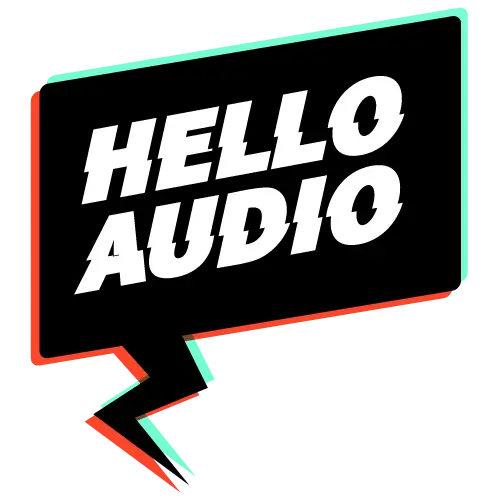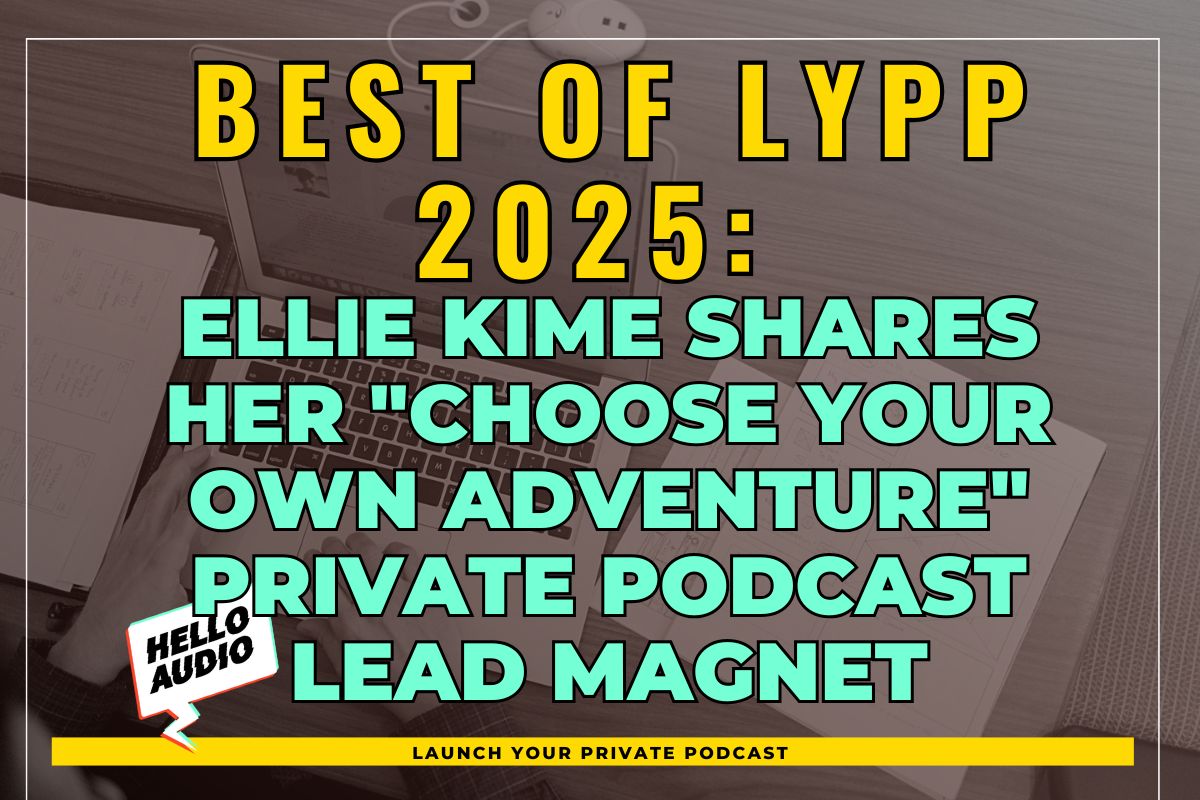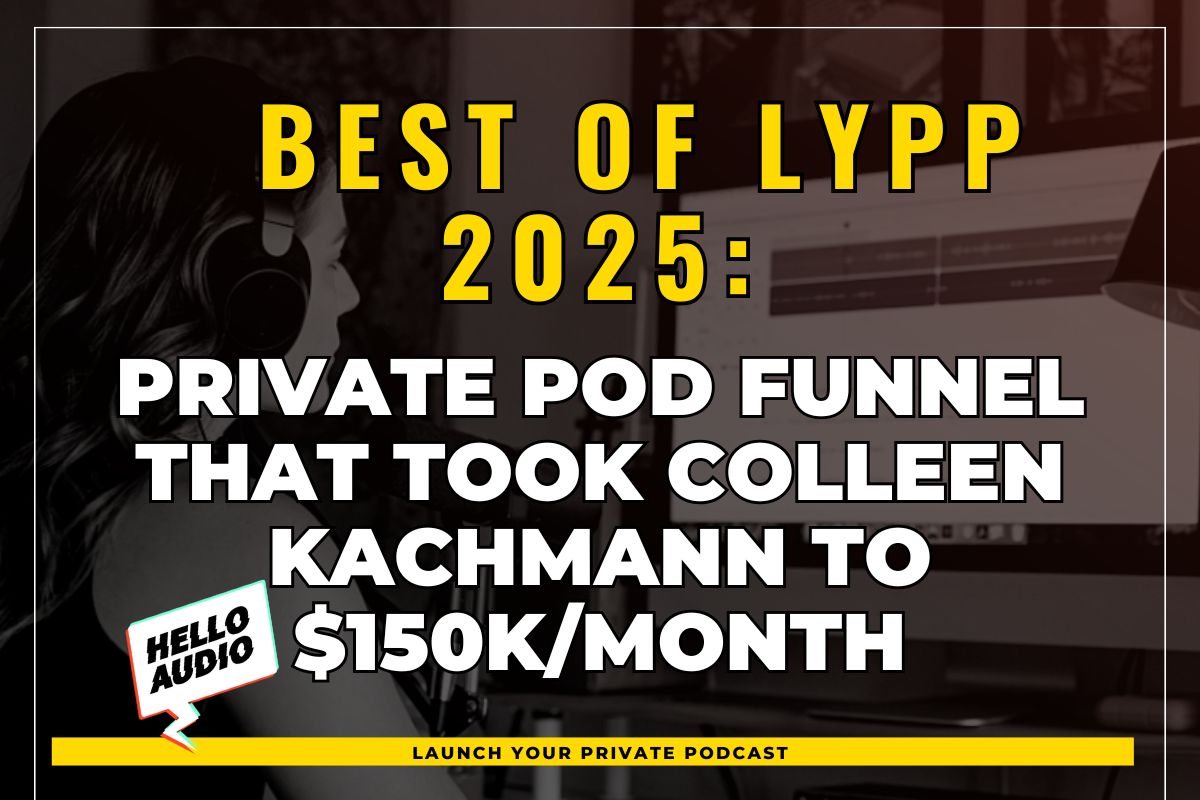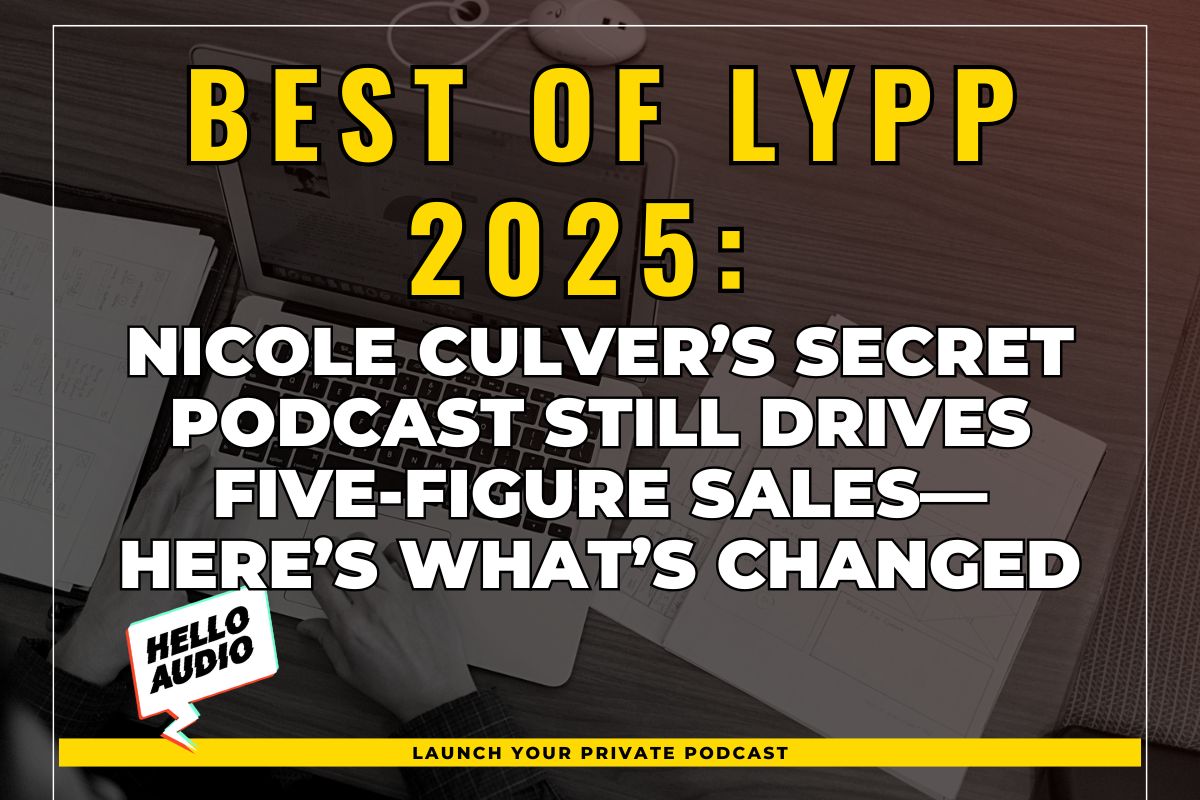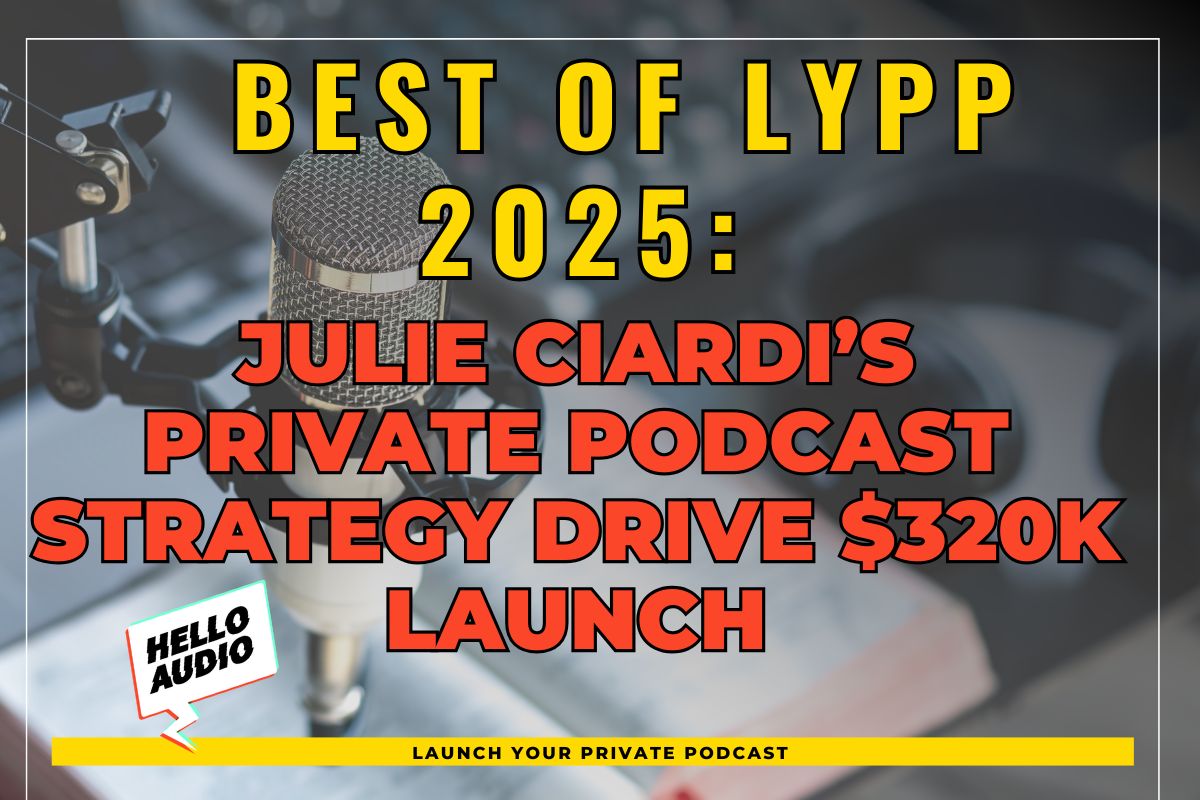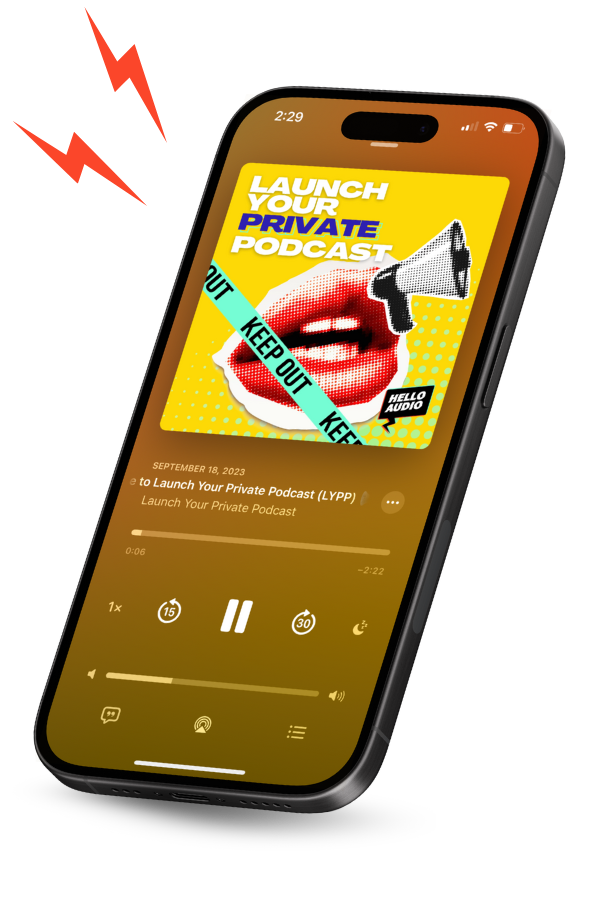Getting people to notice your brand takes a lot of work, and even if you get the traffic, turning them into leads is a task.
This is why you need good lead magnets to turn your visitors into potential clients. Think of them as gifts you offer in exchange for something valuable, like your potential customers’ contact information.
A well-crafted lead magnet can help you achieve your business goals, whether you want to grow your email list, build credibility, or boost conversions.
In this guide, we’ll explore the best lead magnet ideas, give tips on creating effective ones, and help you maximize your lead generation efforts.
If you’re looking for a unique, engaging lead magnet, repurpose video content into audio for better reach. With Hello Audio, you can turn your existing content, such as webinars, training, or coaching sessions, into a private podcast that your audience can listen to anytime, anywhere.

What is a Lead Magnet?
Lead magnets offer visitors resources like ebooks, podcasts, and webinars—basically, a piece of content—in exchange for their contact information. The piece provides information or spreads awareness, which helps a potential customer stay engaged in your product.
It is like a give-and-take situation in which customers get something valuable, and you get to communicate with them to sell your service or product.
All this makes lead magnet an essential part of marketing strategy.
The Purpose of Lead Magnets in Your Marketing Strategy
Marketing brings traffic to your website, but what if the visitors are not converting to customers? That’s where lead magnets can help you!
Lead magnets sound like a powerful tool to attract customers (which it is), but that’s not all; they also efficiently segment customers, offer better-targeted strategies, improve content delivery, and increase ROI.
For example, if you’re selling a service like fitness training, lead magnets like “7-Day Fitness Plan” can help you build credibility. This will help demonstrate your expertise and build trust and authority in your niche.
In a nutshell, lead magnets help you:
- Build a targeted email list.
- Establish authority and trust.
- Increase engagement and brand awareness.
- Qualify leads for your business.
- Drive sales and conversions.

What Makes a Good Lead Magnet?
Lead magnets are good for marketing, but not all ideas yield the same results. Certain characteristics are required for an effective lead magnet.
Let’s look at them:
Relevance to the Audience
Your best resource will not work if your target audience doesn’t resonate with it. You need good-quality content that needs to serve its purpose.
You can capture their attention and encourage engagement by aligning your content with their pain points and aspirations.
High Perceived Value
Your lead magnet should justify their contact information! The content you’re providing should be unique and of some value because if someone can find it elsewhere, they would not want to share their personal information.
The more useful and problem-solving the content, the better the chances of potential leads signing up. Assess if your lead magnet is saving someone time or making their life better in some way; that’s how a magnet needs to work.
Credibility and Trustworthiness
Certain lead magnets like surveys, reports, and ebooks bring authority to your content. However, it won’t be perceived as credible if you don’t back it up with research and data.
A well-researched, fact-based lead magnet helps build trust with potential customers.
Encourages Further Engagement
Your lead magnet is priceless if you find the right balance between what to give and how much to give. To make a really good magnet, you need to give some value while saving some for the future, which will compel them to come back for more.
For instance, you create a free tool, but users must sign up or pay to access the full version. Remember, the tool has to be valuable enough to spark curiosity in the audience.
Easily Shareable Content
Shareable content brings in more leads! If your content gives someone valuable information or is entertaining, they would like to share it in their community. It’s a digital word-of-mouth promotion.
Lead magnets should be designed to be shareable, making it easy for users to distribute them among their network.
Clear Call-to-Action (CTA)
A lead magnet should typically include a sign-up form, a landing page, or a thank-you page.
It is basically a clear conversion path that guides users toward the next step in their customer journey, whether signing up for a consultation, making a purchase, or accessing more content.
Supports Your Business Goals
An effective lead magnet should align with your overall business goals and provide value to your customers.
Whether you want to generate sales, build brand awareness, or just grow an email list, the lead magnet should support your company’s strategic objectives and lead prospects back to what you initially promised when they signed up.

How to Use Lead Magnets Throughout the Funnel
Most people treat lead magnets like bait for the top of the funnel. This makes perfect sense when you want to grab attention and offer free items in exchange for an email. However, the fact is that people don’t always enter your funnel at the top. And even if they do, you still need to keep them moving forward.
The smarter approach? You need to create distinct lead magnets for each stage of the funnel. You have to think of it as if you’re not just doing this to attract leads, but rather to qualify them, educate them, and nudge them closer to making a purchase.
Let’s break it down:
Top-of-Funnel (Awareness Stage)
At the top of the funnel, your goal is simple: you need to get noticed. This is where people are just starting to explore a platform or opportunity. They’re not yet ready to make a purchase; they’re barely prepared to hand over their mail.
Lead magnets that work here:
- Quizzes
- Templates
- Checklists
- Short guides
- Free tools or assessments
Think light, helpful, and highly relevant. For example, a small business accountant might offer a “What’s Your Tax Risk Score?” quiz. It’s zero-pressure, instantly useful, and gets people into the funnel without asking much of them.
Middle-of-Funnel (Consideration Stage)
After you tell them you exist, they start conducting their own research. Apart from you, they also look for other options and start comparing. You have to be smart about how you place yourself as the solution they’re looking for.
Lead magnets that work here:
- In-depth whitepapers
- Comparison guides
- Email courses
- Case studies
- Webinars
Here’s where substance matters. Say you have a project management software company. A downloadable guide titled How We Helped a Team Cut Project Timelines by 40% is gold. It speaks directly to someone actively considering solutions like yours.
Bottom-of-Funnel (Decision Stage)
This is your conversion zone. People here already know their options. They’re just deciding who to go with. The goal now? Remove friction, reduce doubt, and make the next step a no-brainer.
Lead magnets that work here:
- Free trials
- Product demos
- Discount codes
- ROI calculators
- Personalized audits or consultations
Think about what gives them the final push. If you have a content creator platform, offer a free 7-day trial and a live onboarding call. If you have an agency, offer a personalized strategy audit based on a few simple questions. These are lead magnets too, they just look and feel different than a quiz or checklist.

11 Best Lead Magnet Ideas
Here are 11 best lead magnet ideas that you can implement for your company:
1. Whitepaper
A whitepaper is an informational piece of content, like a detailed report or guide, that makes your audience aware of a complex issue and presents a solution to it. This idea best suits a B2B sales pitch or an academic paper.
It includes data, expert analysis, and actionable insights to educate the audience.
Whitepapers help you establish authority and position your brand as an industry thought leader. It reaches out to leads who are serious buyers or decision-makers looking for in-depth information.
2. Webinars
Webinars are video content, such as live or recorded online presentations, that help their audience dig deeper into a topic and clarify their doubt in a Q&A session.
Apart from Q&A sessions, it includes expert discussions or hands-on demonstrations. And if you post on-demand webinars after the initial event, they’ll attract leads for months.
53% of marketers say that webinars generate the most high-quality leads. But remember to keep the event’s topic directed towards a specific pain point.
3. Podcasts
The rising demand for podcasts shows their popularity among the audience. Podcast listeners worldwide are forecasted to reach 651 million by the year 2027, which is a lot of leads!
Podcasts are audio episodes or series that serve as great lead magnets for businesses. They offer valuable, on-demand content, helping creators engage potential customers over time. By creating a podcast series on a relevant topic, you can attract subscribers who are interested in your niche, allowing you to build a loyal audience.
Podcasts allow you to offer expert discussions, interviews, or industry insights in an audio format that listeners can consume while commuting or working.
You can use podcasts to showcase thought leadership, share success stories, or dive deep into industry trends. Consistently delivering high-quality, engaging episodes will not only attract listeners but also build trust, keeping leads coming back for more.
Want your content to be turned into a podcast? Hello Audio lets you quickly convert your existing videos and audio into private podcasts. It then auto-publishes them on popular platforms like Overcast, Spotify, and more.
Learn more with an instant demo.

4. Ebook
Ebooks are just the digital form of a book, usually in PDF format. They provide valuable, educational content on a specific topic. They are typically more detailed than a blog post but shorter than a traditional book.
While they’re a lot like whitepapers, ebooks are written in a conversational way, which is easy to read and aren’t data-heavy.
They make great lead magnets because of their ability to provide in-depth knowledge and comprehensive solutions.
5. Templates
Templates make anyone’s life easier! Those who have them don’t have to create a spreadsheet, checklist, or other informational content from scratch.
Templates give readers a ready-made framework to customize their documents or resources that help complete tasks efficiently.
It helps professionals keep the quality of their work consistent without making much effort.
6. Checklist
A checklist is a part of templates, but this lead magnet is efficient enough to deserve a separate spot in this list.
Simply put, a checklist is a list of items or tasks that need to be completed or checked. It offers practical solutions that make them highly actionable and provide instant gratification.
7. Product Demos
A product demo makes it easy for users to understand a product or service. It is a guided walkthrough of your product or service, which can be presented live as a sales pitch or through a pre-recorded video.
If visitors see how your product solves their problems, they will not mind sharing their personal information to learn more about it.
It builds great trust by addressing concerns in real-time and leads to higher conversion rates.

8. Case Studies
Case studies are a great way to showcase the success of your products or services. But using them as a lead magnet requires some thought. Consider offering them as downloadable files behind a registration form or use them as a conversion tool to encourage sign-ups.
Audiences at the bottom of the funnel are more interested in reading case studies, which gives them the last push to buy your product or service.
9. Exclusive Discount
Audiences would love to get a sweet deal for your product. Discounts serve as an incentive for visitors to leave their contact information for you.
Exclusive discounts are special offers given to those who sign up for your email list or take a specific action.
It hits two targets with one arrow: it pushes people to buy your product and provides a direct marketing channel for people who are interested in your brand.
10. Newsletters
Email newsletters have been in the industry for many years now. You can find them all over the web. Newsletters are regularly delivered by email. Some provide exclusive insights, industry news, and tips, while others serve as a gateway to a lead program.
It’s a common practice where brands pitch their products or deals between regular insights or news.
Newsletters are a great way to maintain regular contact with your audience, distribute relevant content, and drive more engagement. They can also help introduce subscribers to other lead magnets or marketing programs, making them an effective entry point into your broader marketing automation strategy.
11. Online Courses
Online courses provide educational materials to turn your audience into leads. They are structured educational programs, like mini-courses or masterclasses, that provide in-depth training on a specific subject.
When your courses add value to the audience, you can ask for more, like asking them to join your paid course; you just have to give a quality free course to entice them for more.
Learn how to market online courses effectively in our guide—and check out some virtual training best practices while you’re at it.

Lead Magnet Ideas for Coaches
As a coach, your lead magnet needs to be more direct towards showcasing your expertise to build trust and bring potential clients.
Here are some lead magnet ideas you can try:
- Free Coaching Session: A short coaching session after they sign up for a discovery call. This will help your potential clients experience your coaching firsthand and increase conversions.
- Personalized Assessment or Quiz: A short, interactive quiz such as “What’s your ideal learning style?” for an educational coach or “What’s your current health goal?” for a health coach. It helps engage audiences in a fun way and also collects clients’ pain points.
- Goal-Setting Workbook: It is a downloadable workbook that guides users through setting and achieving their goals. It encourages action, making users feel progress immediately.
- Free Mini-Course or Video Training: Coaches can create a short series of training videos or an email-based mini-course, such as “Study strategies for better focus” or “How to stay motivated.” This is a great way to showcase their expertise and potential.
- Exclusive Community Access: A private community is enticing for audiences who are interested in your niche. It offers exclusive content, discussions, and support for its members.

Creative Lead Magnet Examples
Here are some creative lead magnet examples that are working in the real world:
Geekout by Matt Navarra Newsletter
Matt Navarra’s Geekout newsletter is a go-to resource for social media professionals, marketers, and tech enthusiasts who want to stay ahead of the latest content creator platform updates, trends, and industry news.
It works because it delivers the latest updates, ensuring subscribers are always informed. Also, Matt is a well-known social media consultant, so his commentary adds credibility and value for readers.
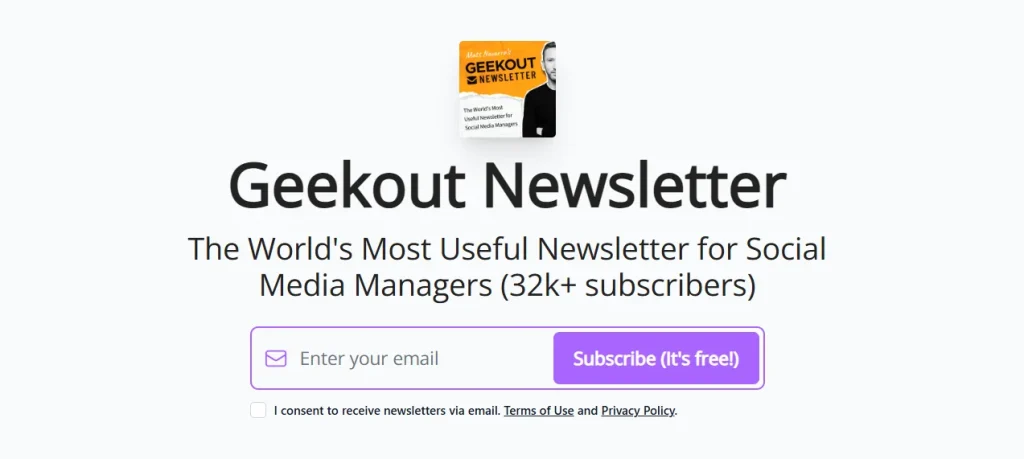
Airtable Demo Videos
Airtable’s product demo video is an excellent example of a lead magnet that uses animation and storytelling to present the platform’s versatility.
They don’t dive straight into technical details; the video takes a broad, top-of-the-funnel approach by first highlighting various use cases that appeal to a wide audience.

Canva’s Free Templates
Canva’s free templates are a powerful lead magnet example! It offers immediate value while subtly encouraging users to upgrade.
The low barrier to entry makes sign-ups easy for visitors, and their hands-on use familiarizes them with Canva’s tools, which smartly increases the likelihood of paid conversions.
Additionally, their free templates are highly shareable, leading to organic growth.
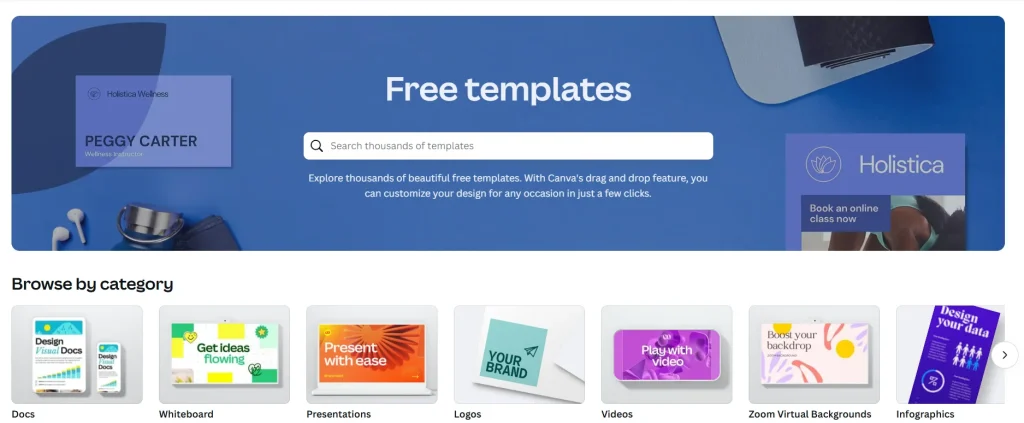
Choosing the Right Lead Magnet for Your Audience
It doesn’t matter how polished your lead magnet is; if it’s not what your audience cares about, they won’t convert. It’s about figuring out what works.
Let’s walk through that:
Start with Their Pain Points
Don’t lead with what you want to sell. Start by figuring out what your ideal customer is struggling with. What’s keeping them stuck? What are they Googling at 2 AM? That’s where your lead magnet should meet them.
If you don’t know the answer, ask. Use a quick poll, a one-question survey, or even a casual post on social media. People will tell you what they want if you ask the right way.
Don’t Just Collect Emails
The bar for attention is high. People are sick of bland PDFs that promise results but say nothing new. So here’s the test: does your lead magnet help someone make a decision, solve a small problem, or take their next step?
If yes, it’s a winner. If not, it’s just another file clogging their downloads folder.
Actionable content builds trust. That’s what leads to sales later on.
Match the Format to Your Audience’s Energy
A founder with no time isn’t going to sit through a 45-minute webinar. A visual learner might skim a blog post but devour an infographic. The format of your lead magnet matters as much as the topic.
So pay attention to how your audience consumes content. Look at your most clicked blog posts. Your most-watched Reels or your email open rates. The clues are all there.
Then, build lead magnets in those formats.
Test Small and Iterate Fast
You don’t need to guess what works; you just need to test. Run two different lead magnets side by side. Promote them the same way. See which one gets more signups and better engagement.
Sometimes, a simple checklist will outperform your beautifully designed eBook. The only way to know is to test, then tweak.
Personalisation Makes Everything Work Harder
If your lead magnet is relevant to the audience, there’s a higher chance that it will grab their attention.
That’s where quizzes, scorecards, or tailored downloads shine. They’re dynamic and feel one-to-one, even when you’re marketing to thousands.
Bottom line: The right lead magnet is the one your audience asks for without knowing they’re asking. If you pay attention, they’ll tell you exactly what they need.

How to Create a Lead Magnet – Best Practices
Before you get started on creating your lead magnets, here are some useful tips to craft a compelling one:
- Know Your Audience: You first need to know who your audience is and what they need. The more specific you are, the more valuable your offer will be to them.
- Solve a Specific Problem: Offering generic solutions will not get you anywhere; you have to provide an immediate solution to one clear problem your audience faces.
- Make It Easily Consumable: People have busy lives and want something they can consume quickly. Keep your lead magnet short, actionable, and easy to digest.
- Use a Compelling Title: Instead of generic names, use benefit-driven titles to grab attention, like “7-Point SEO Cheat Sheet to Rank #1.”
- Offer Instant Gratification: People love getting stuff instantly, be it food or content. Ensure your lead magnet is delivered immediately after someone signs up.
- Use an Attractive Design: A well-designed lead magnet should look professional and add perceived value. Use clean layouts, readable fonts, and eye-catching visuals to make it more appealing.
- Optimize the Sign-Up Form: Use action-driven call-to-action (CTA) buttons. Also, to reduce friction, stick with essential details for your leads, like name and email.

Where and How to Promote Your Lead Magnet
Now that you’ve decided what lead magnets to create, it’s time to promote them the right way and at the right place. The key is to meet your audience where they already are, then give them a clear reason to click.
Here are the most impactful places to promote your lead magnet:
- Your Website: Use pop-ups, sticky bars, or embedded forms on your homepage, blog, and product pages. Trigger them based on scroll depth or exit intent so they show up at the right moment, not randomly. Done right, they feel helpful, not pushy.
- Social Media: Share it often and everywhere. Turn your lead magnet into a piece of content. Post about it with a strong hook, update your bio links, use Instagram Stories, Highlights, and pinned posts to keep it visible. Show why it’s worth clicking, not just that it exists.
- Paid Ads: Run targeted campaigns on Facebook, Instagram, or Google. If your lead magnet converts well, scale it. Utilize paid ads to target cold audiences, retarget warm leads, or replicate your best prospects with lookalike audiences. Short video clips or carousels tend to work well for lead magnets.
- Email: Promote it to your current list. Even if your lead magnet is meant to attract new leads, sharing it with your existing subscribers can lead to referrals, forwards, or new insights about what your audience finds valuable. Bonus: Segmenting your list based on interests can be helpful.
- Blog Posts: Add content upgrades right where people are already reading. Drop in a bonus checklist, template, or worksheet inside relevant blog posts. If someone’s already interested in the topic, they’re much more likely to opt in for something extra that builds on it.
- SEO: Optimize your landing page to show up in Google search. People are actively seeking resources, so ensure yours can be easily found. Use keywords your audience is actually searching for. Add them to your headline, page title, and meta description. Then, link to the page from your blog or other relevant pages to give it a traffic boost.
- Strategic Partnerships: Team up with influencers, service providers, or brands that serve the same people you do. You can co-create a lead magnet; it could be a quiz, a webinar, or even a downloadable guide. Ensure the value aligns with both your audiences, and provide partners with a simple link or post to share.
- Virtual Events: Offer it during a webinar, summit, or online workshop. Don’t just give value during the event, offer your lead magnet as a follow-up resource. Share a dedicated landing page link during the session, mention it multiple times, and include it in post-event emails.
- Online Communities: Join relevant groups, forums, or subreddits that align with your interests. Answer questions, contribute something useful, and only link to your lead magnet when it actually fits the conversation. No spamming – just being helpful and visible in the right places.
- Guest Appearances: Plug your lead magnet on podcasts or YouTube shows. When the host asks where listeners can learn more, this is your moment. Share a short, memorable URL and make the offer clear. Bonus points if the lead magnet connects directly to the topic you just spoke about.

Frequently Asked Questions (FAQs)
Here are some commonly asked questions:
What Are the Key Differences Between Lead Magnets and Gated Content?
- Lead magnets are a specific type of gated content designed to attract leads by offering valuable, short resources (like checklists, templates, or mini eBooks) in exchange for contact information. The key purpose is to capture potential customer details quickly and effectively.
- On the other hand, gated content can be broader and more in-depth, such as whitepapers, exclusive reports, or premium webinars.
While all lead magnets are a form of gated content, not all gated content serves as a lead magnet.
Gated content that requires users to provide information before accessing it may not always be crafted to generate leads; it could also be focused on delivering more detailed or premium content to an existing audience.
Can Lead Magnets Be Used for Retargeting Campaigns?
Absolutely! Lead magnets are great tools for retargeting campaigns. If someone visits your website but doesn’t convert, you can retarget them with ads promoting a high-value lead magnet.
This helps keep your brand on the audience’s mind and encourages them to engage with your content. You can also segment leads based on which lead magnet they downloaded and retarget them with relevant offers later.
How Do You Measure the Success of a Lead Magnet?
You can measure the success of a lead magnet using several key metrics, including conversion rate, engagement rate, and lead quality.
Track the number of visitors who sign up for the offer compared to total page views (conversion rate). Also, monitor whether leads open emails and engage with your content after downloading the lead magnet.
Ultimately, a successful lead magnet should generate high-quality leads that move through your sales funnel.
How Often Should You Update Your Lead Magnets?
It depends on your industry and content type, but updating them at least once a year is a good practice.
However, if your lead magnet includes statistics, trends, or best practices, you should refresh them frequently to keep them relevant.
Additionally, if a lead magnet isn’t performing well, consider tweaking the design, title, or content to improve engagement and conversion rates.
Do Lead Magnets Work for Small Businesses?
Yes, lead magnets are especially effective for small businesses because they help build trust and grow your email list without a huge ad budget.
The key is offering something genuinely useful and relevant to your ideal customer.
What Is a Good Conversion Rate for a Lead Magnet?
A solid benchmark is 5–15% conversions on your opt-in landing page. Top performers achieve 20–25%, with the highest reaching 30% or more.
If you’re consistently converting over 10%, you’re doing well. Below that, it’s worth improving your offer or presentation.
Do Video Lead Magnets Perform Better Than PDFs?
It depends on your audience. 47% of marketers say both video and text-based magnets perform best.
Videos often feel more personal and engaging, especially for visual learners. But PDFs are easier to skim and download. Test both to see what your audience responds to because there’s no one-size-fits-all answer.
Conclusion
Now that we’re at the end of the topic, it’s clear that lead magnets are more than just freebies. They are your strategic assets that drive growth by offering value and engaging your audience.
From webinars to eBooks, the right lead magnet helps you build trust, segment your audience, and convert visitors into loyal customers. Create lead magnets that resonate and deliver results, which you can do by understanding your audience’s needs and crafting a compelling offer accordingly.
And what better way to engage your lead than with audio content? With Hello Audio, you can effortlessly repurpose your existing content into podcast-style lead magnets that are easy to consume.
Want to see how it works? Sign up for a free trial!

